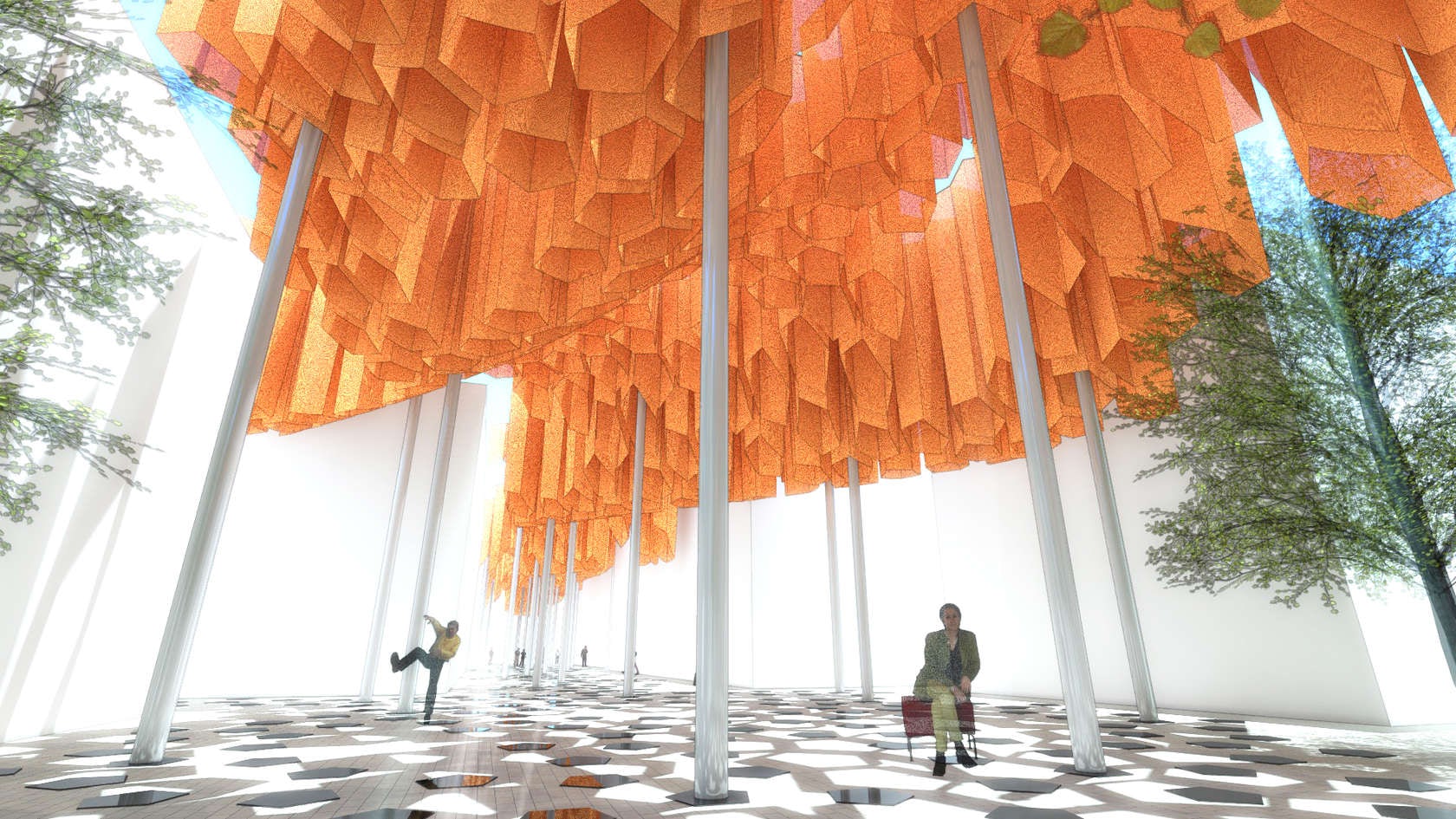Since the Future of Shade competition began in 2013, competition partners Sunbrella® and Architizer have received hundreds of entries that intriguingly reconceive the way Sunbrella performance fabrics provide shade — and expand fabric’s role in shaping our built environment. In some cases, the imaginativeness of a submission is matched by the renown of its author. Perhaps most notable, Mexican architect Michel Rojkind’s Yanay Hotel took one of the competition’s top three slots in 2014.
The competition has produced an additional benefit for the architecture and design communities: By focusing precisely on submissions’ interpretations of the Future of Shade mission, its juries have given crucial support to young designers and visibility to studios based in the farther corners of the world.

Hyunjeong Kim’s Draping Scenery
This year’s jurors included Seattle-based landscape architect Daniel Winterbottom, Miami-based architect Chad Oppenheim and Ennead Architects founding partner Susan Rodriguez. The 2016 Future of Shade competition welcomed three types of submissions: a Wellness Garden for a cancer treatment center, a portable temporary shelter for the Humanitarian Challenge and a courtyard shade design to protect against the sometimes-harsh sun in the Miami Design District for the Building Shade challenge. Just as important, this fourth annual event supported emerging designers in each category. The wins validate remarkable talents and prepare these winners for new opportunities.
Perhaps no Future of Shade participant grasps that latter point better than design student Hyunjeong Kim. From her temporary base at the University of Arts Berlin, Kim entered the Wellness Garden Challenge to harness her creativity to help people with cancer.
2016 Sunbrella Future of Shade – Wellness Garden Grand Prize Winner from Sunbrella on Vimeo.
Imagining sunlight filtering through tree canopies, her entry Draping Scenery loops laser-cut Sunbrella fabric under and over large frames so that hospital patients can enjoy shade with friends and family or sit and swing in the draped portions. The various cutouts effect a dappling pattern found in nature. Draping Scenery not only reveals Kim’s empathy as a young designer, but also her savvy. The Korean-born phenom has won other competitions, including the inaugural VELUX International Design Awards, prior to this year’s Future of Shade.

In addition to earning a professional spotlight, the Future of Shade winners have used their successful proposals to culminate a career of research. Trained in sociology and believing “that good design can change the world,” the Cochabamba, Bolivia–based artist and designer Jonathan Balderrama was drawn to enter the Future of Shade Humanitarian Challenge. “My work essentially consists of experimenting with shapes, colors, materials, structures … and how after merging these together we can achieve spaces and objects that can be useful for people,” Balderrama said.
2016 Sunbrella Future of Shade – Humanitarian Grand Prize Winner from Sunbrella on Vimeo.
Balderrama’s winning proposal Pull is a portable shelter concept to be deployed in humanitarian crises. The cart has a fabric-covered roof that can expand to shade areas beyond the cart’s footprint or to connect to other Pull carts to form communal gathering spaces. Although designed with an eye to natural disasters and other relief situations, Balderrama’s design also reflects on his own body of work, which includes multiple installations and pavilion-like structures that provide senses of safe enclosure to users of large and outdoor spaces.

Jonathan Balderrama’s Pull

Santiago, Chile–based architects Alberto Fernandez and Benjamin Fernandez reflected on professional best practices through their Future of Shade submission. Foremost, the duo was interested in creating design that can be realized, namely by accommodating existing conditions in the Miami Design District. “You must respect what you have,” as Alberto Fernandez says here, “ — and push your ideas to a higher level. You can change the perception of space using simple elements.”
2016 Sunbrella Future of Shade – Building Shade Grand Prize Winner from Sunbrella on Vimeo.
Their winning entry in the Building Shade Challenge category, called Quasicrystals for Design, specifically accommodates the spectacular architecture housing luxury consumer brands in the Miami Design District. The proposal comprises a honeycomb-like arrangement of saffron-colored lanterns made of Sunbrella fabric. It provides shoppers with the shade they need as they travel between stores, without interrupting their views to the districts’ impressive storefronts. Quasicrystals marries poetry and pragmatism by creating shade patterns that change throughout the day as the sun traverses the sky and breezes change direction. Additionally, the shade design allows the urban heat buildup of Miami hardscaping to escape through its channels. “The most important challenge was trying to link that reality with our local vision of what is architecture,” Alberto Fernandez concludes.

Alberto and Benjamin Fernandez’s Quasicrystals
All three winners of this year’s Future of Shade competition earned $10,000 prizes for their work. The competition has produced much more for these individuals, however — whether boosting a nascent career, nourishing a long-running investigation or exemplifying how to harness creative expression for service. Just as the Future of Shade is expected to widely benefit the design dialogue, so these design professionals are ones to watch on that scene.

What do you think of these innovative shade designs? How can shade influence the aesthetic and functionality of the built environment? See more creative shade designs at futureofshade.com and join the conversation here and on social media, #futureofshade.






